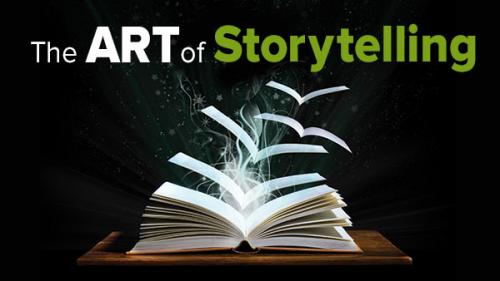TheGreatCoursesPlus - The Art of Storytelling: From Parents to Professionals
Enhance the stories you tell every day in your personal and professional life by learning the methods experienced storytellers use to create and tell memorable tales.
1: Telling a Good Story
- What qualifies as a story? Learn the significance of storytelling in various cultures; the ways this art is distinct from other forms of performance or literary thought; and how the craft of professional storytelling can help you improve your own storytelling abilities. Listen to tales from the professor's life and get an introduction to the "storytelling triangle."
2: The Storytelling Triangle
- Telling a story is a three-way dynamic relationship between you, and the story, and the audience. In the first of three lectures that analyze this storytelling triangle, look at The Old Maid and other stories in depth to understand how the process of storytelling works. Then, consider why you're drawn to certain stories.
3: Connecting with Your Story
- What kinds of stories appeal to you most? Look at the variety of stories that are available for you to tell and some practical resources for finding them. Assess the intellectual, social, and cultural connections we develop with stories and identify how you can add depth and context to the stories you tell.
4: Connecting with Your Audience
- Focus on this second aspect of the storytelling triangle-your relationship with your audience-by looking at the physical, social, emotional, and intellectual contexts of this relationship and how stories work to bring audiences together. End with an exercise that helps you identify stories that connect with a variety of audiences.
5: Telling Family Stories
- Examine the hidden meanings of the family-story genre, including why we tell family stories, how stories organically emerge from families, and what remembering these stories entails. With these hidden meanings in mind, consider how you can tell your own family stories in a way that captures your audience's attention.
6: The Powerful Telling of Fairy Tales
- With classic stories, fairy tales, and myths, there's a lot more than "they all lived happily ever after" going on beneath the surface. Use Little Red Riding Hood and other fairy tales to understand the psychology of storytelling and what fairy tales do for children in particular. Then, see why the themes of these tales can be just as appealing to adults.
7: Myth and the Hero's Journey
- Lord of the Rings and Harry Potter are modern examples of a "hero's journey." Use ancient myths from East Africa and ancient Sumeria to break down this structure and investigate why the archetypal figures and pattern of separation, initiation, and return found in the hero's journey resonate so deeply. Pause to consider how you can apply these ideas to craft stories that reach your audience on a me...
8: Tensive Conflict and Meaning
- Dissect the layered process professional storytellers use when preparing to tell a tale, which involves an interconnected cycle of talking, writing, imaging, playing, and rehearsing. Explore the concept of "tensiveness," the dynamic quality that reveals a story's opposing forces; then step back from one of your stories to see the potential relationships between the larger parts of the narrative.
9: Giving Yourself Permission to Tell
- Engage in "stretching" exercises to learn to let go of things that may hold you back from telling your story, and give yourself permission to play with the story, make mistakes, and really immerse yourself in the narrative. Listen to the story Mama's Wings to identify its tensive pulls and unifying themes and images.
10: Visualization and Memory
- Learn to visualize a story's people, places, and events through interactive exercises that get you "seeing" the story in front of you. Explore techniques that help you remember a story without memorization, and methods for immersing yourself in the scene while shifting into "epic mode" to focus on your audience.
11: Discovering Point of View
- There is no such thing as a purely objective narrator. Consider how the narrator's perspective and point of view guide the audience through the story, and how even the most familiar stories can be reinvented by narrating from another character's perspective. See why age, gender, heritage, economics, and temperament shape your vantage point.
12: The Artful Manipulation of Time and Focus
- Explore how you as a narrator can artfully guide the audience's experience of the story by looking at techniques for controlling events, manipulating time, and making the past tense feel present. Consider when to take your narrator out of the characters' conversations to increase the pacing and energy.
13: Narrator-Bridging Characters and Audience
- Begin thinking about the narrator's relationship with characters and how control may be ceded to certain characters at points throughout a story. Learn how using focal points can distinguish between personalities, and establish the physical and emotional relationship you have with those characters through storyteller Motoko Dworkin's performance of a Japanese folktale.
14: Developing Complex Characters
- How old are your characters? Are they "head-centered," "stomach-centered," or something else? Experiment with gestures and body postures that add depth and dimension to your characters. Then, gain insight into how you can develop characters into memorable people your audience really enjoys seeing in action.
15: Plot and Story Structures
- Does your story need to be told in chronological order? Use your storytelling journal to organize the pieces of your story into a structure that conveys the underlying meaning. Learn to separate plot from emotional arc and gain tools that are useful when you're developing the frame, structure, and resolution of your story.
16: Emotional Arc and Empathy
- From ghost stories to family stories, empathy is crucial in giving your audience an emotional entry point and permission to feel. As you turn from plot sequencing to the development of your story's emotional arc, learn how to build a compelling beginning and emotional climax through an exercise that explores the motivating desire of your primary character from first- and third-person perspectives.
17: Varying the Narrator's Perspective
- Learn to build dynamic tension through your characters and achieve satisfying resolutions. Stories and exercises teach you how to treat third-person statements as if they're first-person accounts and how to let secondary characters narrate for themselves or serve as "little narrators." Understand ways to personify the negative force your protagonist is struggling with so it becomes a "little chara...
18: Vocal Intonation
- Focus on using vocal intonation to evoke the "sensorium" of a story for your audience with a lesson on how the voice operates, featuring warm-up techniques. Perform mouth and tongue stretches and articulation exercises, then learn how pace, pauses, and sound effects can create character distinctions, contribute to the emotional arc, and draw in your audience.
19: Preparing to Perform
- Synthesize everything you've learned so far by integrating the elements of storytelling in writing and performance exercises that help you look at your story from various angles. Create a story outline, tell a "side-coached" version of your tale, do an exaggerated run-through, and write a script. Finally, consider the meanings your story holds.
20: Putting Performance Anxiety to Good Use
- Whether you consciously deal with performance anxiety as a barrier to communicating with others, or you want to become a more energized and engaging storyteller, this lecture is designed to teach you the physiology behind performance anxiety; the correlation between anxiety that debilitates and energy that enlivens; and practical tools for channeling nervous energy.
21: Adapting to Different Audiences
- Consider the physical parameters of informal and formal storytelling scenarios; how stories emerge in these different settings; and what specific audiences-from children to employees-typically need from a story. Learn how to handle yourself as a storyteller in relaxed situations, boardroom settings, and the classroom environment.
22: Invitation to the Audience-Mindset
- How do you get and keep your audience's attention? In this lecture, you'll learn about on-ramps and off-ramps-how to lead into your story and make it relevant, and how to conclude gracefully. Acquire specific tools for putting your audience in the proper mindset to listen, whether you're engaged in conversation, giving a presentation, or telling a story to children.
23: Keeping Your Audience's Attention
- Once you've hooked your audience, how do you keep them from straying? Learn general rules to live by as a storyteller and ways to keep your audience engaged, including the use of audience participation, props, and repetition. Learn to adjust to what the audience needs in the moment and to cope with interruptions.
24: Remember Your Stories-The Power of Orality
- Wrap up the course with some final considerations for keeping your audience interested, from the technical aspects of microphones and PowerPoint, to the more nuanced ways that you can read audiences and understand their needs on the spot. Finally, return to the nature of orality itself as a cultural force that shapes us all.

The.Art.of.Storytelling.From.Parents.to.Professionals.part1.GC.rar
The.Art.of.Storytelling.From.Parents.to.Professionals.part2.GC.rar
The.Art.of.Storytelling.From.Parents.to.Professionals.part3.GC.rar

































